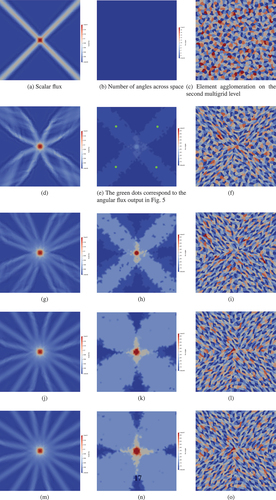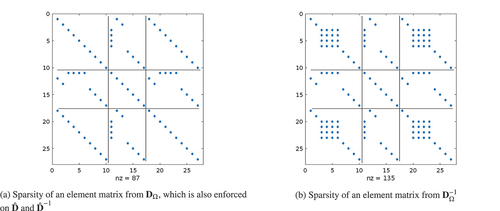Figures & data
Fig. 1. Angular domains showing angular adaptivity focused around a single important direction, namely, and
in a two-dimensional simulation.
![Fig. 1. Angular domains showing angular adaptivity focused around a single important direction, namely, μ∈[0,1] and ω∈[1.47976,1.661832] in a two-dimensional simulation.](/cms/asset/531d4f89-126e-4ae4-88a2-8ec035485f46/unse_a_2240658_f0001_oc.jpg)
Fig. 2. Sparsity of the streaming/removal operator with and without angular adaptivity, after three adapt steps. The solution of the adapted problem is shown in with the spatial distribution of adapted angles shown in .

Table
TABLE I Results from Using AIRG on a Pure Streaming Problem with CF Splitting by Directional Element Agglomeration
Fig. 4. Adapt results for a two-dimensional pure streaming problem with a small source at the center of the domain, allowing a maximum of three levels of regular angular refinement (giving a maximum number of angles as 64). The first column shows the scalar flux, and the second column shows the number of angles across space. The third column shows the resulting element agglomeration on the second spatial grid if the directional algorithm in Sec. IV.A is used (an element coloring is used to show individual agglomerates). The rows show consecutive regular adapt steps.

Fig. 5. Angular flux at four spatial points after two regular adapt steps in a pure streaming problem with a small source at the center of the domain. The four spatial points correspond to the green dots shown in .

TABLE II Results from Using AIRG on a Pure Streaming Problem with CF Splitting by Falgout-CLJP
Fig. 6. Field of values of the streaming operators on the third spatial grid. Blue is uniform level 3 angular refinement, and red is an adapted angular discretization with a maximum level of refinement of 3.

Fig. 7. Adapt results for a two-dimensional pure scattering problem with total and scatter cross sections of 10.0 with a small source at the center of the domain, allowing a maximum of three levels of regular angular refinement (giving a maximum number of angles as 64). The first column shows the scalar flux, and the second column shows the number of angles across space. The third column shows the resulting element agglomeration on the second spatial grid if the directional algorithm in Sec. IV.A is used (an element coloring is used to show individual agglomerates). The rows show consecutive regular adapt steps.

Fig. 8. Angular flux at three spatial points after three regular adapt steps in a pure scattering problem with a small source at the center of the domain. The three spatial points correspond to the green dots shown in .

TABLE III Results from Using Additive Preconditioning on a Pure Scattering Problem with CF Splitting by Element Agglomeration
TABLE IV Results from Using Additive Preconditioning on a Pure Scattering Problem with CF Splitting by Falgout-CLJP
Fig. 9. Adapt results after five regular adapt steps in a pure streaming problem with adapt steps prior to the final step solved with wavelet-based reduced tolerance to determine convergence.

TABLE V Results from Using AIRG on a Pure Streaming Problem with CF Splitting by Falgout-CLJP with Adapt Steps Prior to the Final Step Solved with Wavelet-Based Reduced Tolerance to Determine Convergence
TABLE VI Total and Rescaled WUs from Using AIRG on a Pure Streaming Problem with CF Splitting by Falgout-CLJP*
TABLE VII Results from Using Additive Preconditioning on a Pure Scattering Problem with Adapt Steps Prior to the Final Step Solved with Wavelet-Based Reduced Tolerance to Determine Convergence
TABLE VIII Total and Rescaled WUs from Using AIRG on a Pure Scattering Problem with CF Splitting by Falgout-CLJP*
Fig. 10. Adapt results after three regular adapt steps in a pure scattering problem with adapt steps prior to the final step solved with wavelet-based reduced tolerance to determine convergence.


